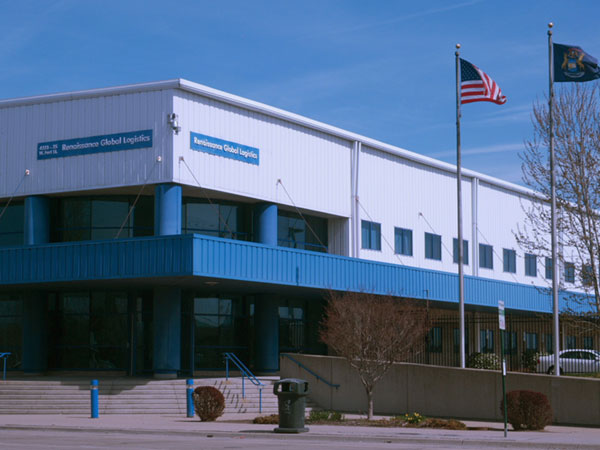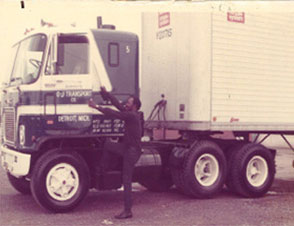
AN AREA WITH A STORIED AUTO HISTORY
Many of the earliest automobile companies and suppliers in the Detroit area are no longer remembered today, and a surprising number of them set up shop in Southwest Detroit, in an area roughly from the intersection of Clark and Fort Streets north to Michigan Avenue and south toward Jefferson Avenue. The area was well-served by railroads, including the Detroit & Toledo Shore line and the Michigan Central, which were essential for delivering materials and shipping finished products.

One of the first automobile manufacturers in the area was the C. H. Blomstrom Motor Company, founded by Charles H. Blomstrom, who moved to Detroit in 1901 to manufacture gasoline engines for boats and ships at a plant on Second St. For two years he focused his business on marine products, but he was intent on shifting to automobile production. He had been experimenting with automobiles as early as 1897, had produced 25 “Blomstrom” runabouts in 1902, and successfully patented a two-cylinder motor the next year. His initial success allowed him to expand his operations to a 19-acre site on Clark St. near south of Fort, near River Road. And the following year, the Blomstrom Motor Company produced 1,500 automobiles in its signature Queen line, which according to company advertising comprised “Five of the Most Attractive Models Ever Offered by any Manufacturer.” The Queen line was named for a reason, since Blomstrom marketed automobiles directly to women drivers as well as to men.
The auto industry was tough and competitive, however, and after experiencing production problems Blomstrom merged with the Deluxe Motor Car Company in 1906. Yet the new company had problems of its own and produced only 100 DeLuxe autos in the next three years. In 1909, the Everitt-Metzger-Flanders company (E-M-F) assumed control of Deluxe, paying $800,000 in cash (more than $23 million in today’s dollars) for the Clark St. plant, plus patents, drawings, tools, and machines.
Everitt-Metzger-Flanders Co. (E-M-F) was founded in 1908 to produce a medium-priced car. Byron “Barney” Everitt was an auto body manufacturer who helped establish Wayne Motors. William Metzger organized one of the nation’s first auto dealerships and staged the earliest auto shows in Detroit and New York City. He was also involved in the launch of Northern Motor Car Co. and Cadillac Motor Car Co. Walter Flanders had served as Henry Ford’s production manager and had been responsible for innovations that reorganized the production process at Ford’s Piquette plant.

Prior to starting production, E-M-F contracted to sell 5000 automobiles, half of its initial production run, through Studebaker. An established wagon maker and harness manufacturer from South Bend, Indiana, Studebaker had begun to diversify operations by building electric cars. It saw this arrangement as a means to introduce a full line of gasoline engine vehicles to its showrooms. Production problems and tensions between the two management teams led Everitt and Metzger to sell their shares to Studebaker in 1909. They, in turn, started the Metzger Motor Car Co. Tensions between Flanders and Studebaker escalated into a series of financial maneuvers, lawsuits, and board disputes that raged over the next several years, with Studebaker enlisting the banking firm of JP Morgan to secure the balance of E-M-F stock in March 1910.
Flanders held on for a couple of years, leading Detroit E-M-F operations—the Clark St. Plant #3, Plant #1 near the Ford Piquette Plant and a machine shop near the riverfront on Detroit’s east side—to a banner year in 1911. Its sales of 26,762 cars were second only to Ford’s annual total of 69,762. By August 1912, however, Studebaker consolidated its , forcing Flanders out of the company. He rejoined his former partners, Everitt and Metzger, in a short-lived auto firm. Flanders then led the new Maxwell Motors, a company that emerged from that collapse and a more general shakeup among auto manufacturers, to financial success in 1917, during WWI, and eventually to become part of the Chrysler Corporation. Everitt moved on to help launch the Rickenbacker Automobile Company, in partnership with the ace WWI fighter pilot Eddie Rickenbacker, and Metzger later served as Detroit’s Fire Commissioner before aiming skyward and helping start the Stinson Aircraft Syndicate.
For its part, Studebaker built new plants in South Bend during World War I and gradually shifted auto manufacturing there until production at the Clark St. facility ended in 1926. Studebaker was significant in Detroit labor history as well, as one of the first “mass strikes” in the auto industry, led by the radical Industrial Workers of the World (IWW), began at the Clark St. plant in 1913. While the strike was ultimately unsuccessful, the positive response of so many workers to appeals by IWW leaders was among the factors that prompted Henry Ford, several months later, to launch the $5 day.
These are just a few of the many auto-related companies in the early years of the industry near the intersection of Clark and Fort Streets in Southwest Detroit. In addition, a Timken-Detroit Axle facility ran along the west side of Clark St., just north of Detroit Copper and Brass, a company that transitioned to the automobile era by manufacturing hood ornaments and brass parts for the Ford Motor Company. And Paige - Detroit Motor Car Company’s Plant #1, just west of Clark St., began producing automobiles in 1909.
Click to view:
Profiles of the Carl Blomstrom companies that appeared in Robert G. Sudzarek's 1996 tribute to Detroit's auto centennial, "How Detroit Became the Auto Capital of the World"
Two articles spotlighting vintage Blomstrom vehicles. The " rare-as-hens’-teeth" 1905 Queen Model E Light Touring model sold at auction for $80,640 and "while it may not have been the most expensive car that sold at Bonhams’ Amelia Island Auction, it’s one of the oldest and rarest". The 1905 Blomstrom Queen B Runabout was purchased for $52,250. Auto enthusiasts, in particular, may want to be sure to scroll through all the images and descriptions featured here.
E-M-F: Racy Roadsters, Witt Specials, and the Studebaker-Flanders Speedster and The E-M-F Story, Pt 2, an overview of the complex history of E-M-F from the Classic Speedsters’ website, edited by Ronald D. Sieber
One Big Union, Steve Babson’s Working Detroit discussion of the 1913 IWW strike

Auto-related production continues today in this part of Southwest Detroit. The world headquarters for James Group International (JGI) was built at the northeast corner of Clark and Fort St. In the 1980s JGI developed just-in-time delivery systems for seat assemblies at Ford and other warehousing systems to manage Ford’s parts inventory. Today JGI is a diversified logistics provider serving the automotive and other manufacturing industries worldwide. However, the firm’s roots were much more modest, beginning in the 1970s with “two men and a truck.” Its early years were overshadowed by a prolonged dispute with the Interstate Commerce Commission over permitting the entry of minority-owned businesses to engage in the delivery of beer and auto parts.
Click here to view:
The James Group International - The Guide’s Introduction to the James Group and its roots as the O-J Transport Company
O-J Transport ICC Legal Challenge - The Guide’s discussion of the challenges overcome by company founders to ensure that African-American operators could operate in the interstate truck industry
TEXT & RESEARCH - RON ALPERN, DIANNE FEELEY, & DANIEL CLARK





